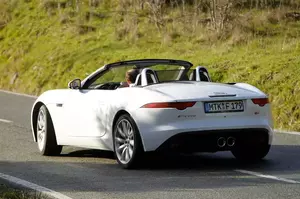
| Vehicle | Precise engine size | Difference from world average | Engine size to consumption ratio | Horsepower from 1 L | Engine size to 100 kg of weight |
|---|---|---|---|---|---|
| SVR 5.0 V8 |
5 L (5000 cc) |
113.1% bigger | 227 cc to 1 mpg | 115 hp from 1 L | 313 cc to 100 kg |
| 3.0 V6 |
3 L (2995 cc) |
27.7% bigger | 125 cc to 1 mpg | 113 hp from 1 L | 187 cc to 100 kg |
| R 5.0 V8 |
5 L (5000 cc) |
113.1% bigger | 227 cc to 1 mpg | 110 hp from 1 L | 294 cc to 100 kg |
| 2.0 |
2 L (1997 cc) |
14.9% smaller | 61 cc to 1 mpg | 150 hp from 1 L | 133 cc to 100 kg |
| P380 V6 |
3 L (2995 cc) |
27.7% bigger | 136 cc to 1 mpg | 127 hp from 1 L | 200 cc to 100 kg |
| P340 V6 |
3 L (2995 cc) |
27.7% bigger | 130 cc to 1 mpg | 113 hp from 1 L | 200 cc to 100 kg |
| P300 |
2 L (1997 cc) |
14.9% smaller | 67 cc to 1 mpg | 150 hp from 1 L | 133 cc to 100 kg |
| Vehicle | SVR 5.0 V8 |
|---|---|
| Precise engine size | 5 L (5000 cc) |
| Difference from world average | 113.1 bigger |
| Engine size to consumption ratio | 227 cc to 1 mpg |
| Horsepower from 1 L | 115 hp from 1 L |
| Engine size to 100 kg of weight | 313 cc to 100 kg |
| Vehicle | 3.0 V6 |
| Precise engine size | 3 L (2995 cc) |
| Difference from world average | 27.7 bigger |
| Engine size to consumption ratio | 125 cc to 1 mpg |
| Horsepower from 1 L | 113 hp from 1 L |
| Engine size to 100 kg of weight | 187 cc to 100 kg |
| Vehicle | R 5.0 V8 |
| Precise engine size | 5 L (5000 cc) |
| Difference from world average | 113.1 bigger |
| Engine size to consumption ratio | 227 cc to 1 mpg |
| Horsepower from 1 L | 110 hp from 1 L |
| Engine size to 100 kg of weight | 294 cc to 100 kg |
| Vehicle | 2.0 |
| Precise engine size | 2 L (1997 cc) |
| Difference from world average | 14.9 smaller |
| Engine size to consumption ratio | 61 cc to 1 mpg |
| Horsepower from 1 L | 150 hp from 1 L |
| Engine size to 100 kg of weight | 133 cc to 100 kg |
| Vehicle | P380 V6 |
| Precise engine size | 3 L (2995 cc) |
| Difference from world average | 27.7 bigger |
| Engine size to consumption ratio | 136 cc to 1 mpg |
| Horsepower from 1 L | 127 hp from 1 L |
| Engine size to 100 kg of weight | 200 cc to 100 kg |
| Vehicle | P340 V6 |
| Precise engine size | 3 L (2995 cc) |
| Difference from world average | 27.7 bigger |
| Engine size to consumption ratio | 130 cc to 1 mpg |
| Horsepower from 1 L | 113 hp from 1 L |
| Engine size to 100 kg of weight | 200 cc to 100 kg |
| Vehicle | P300 |
| Precise engine size | 2 L (1997 cc) |
| Difference from world average | 14.9 smaller |
| Engine size to consumption ratio | 67 cc to 1 mpg |
| Horsepower from 1 L | 150 hp from 1 L |
| Engine size to 100 kg of weight | 133 cc to 100 kg |

| Vehicle | Precise engine size | Difference from world average | Engine size to consumption ratio | Horsepower from 1 L | Engine size to 100 kg of weight |
|---|---|---|---|---|---|
| SVR 5.0 V8 |
5 L (5000 cc) |
113.1% bigger | 227 cc to 1 mpg | 115 hp from 1 L | 313 cc to 100 kg |
| 3.0 V6 |
3 L (2995 cc) |
27.7% bigger | 111 cc to 1 mpg | 127 hp from 1 L | 187 cc to 100 kg |
| R 5.0 V8 |
5 L (5000 cc) |
113.1% bigger | 227 cc to 1 mpg | 110 hp from 1 L | 294 cc to 100 kg |
| 2.0 |
2 L (1997 cc) |
14.9% smaller | 61 cc to 1 mpg | 150 hp from 1 L | 133 cc to 100 kg |
| P300 |
2 L (1997 cc) |
14.9% smaller | 67 cc to 1 mpg | 150 hp from 1 L | 133 cc to 100 kg |
| P340 V6 |
3 L (2995 cc) |
27.7% bigger | 125 cc to 1 mpg | 113 hp from 1 L | 200 cc to 100 kg |
| P380 V6 |
3 L (2995 cc) |
27.7% bigger | 130 cc to 1 mpg | 127 hp from 1 L | 187 cc to 100 kg |
| Vehicle | SVR 5.0 V8 |
|---|---|
| Precise engine size | 5 L (5000 cc) |
| Difference from world average | 113.1 bigger |
| Engine size to consumption ratio | 227 cc to 1 mpg |
| Horsepower from 1 L | 115 hp from 1 L |
| Engine size to 100 kg of weight | 313 cc to 100 kg |
| Vehicle | 3.0 V6 |
| Precise engine size | 3 L (2995 cc) |
| Difference from world average | 27.7 bigger |
| Engine size to consumption ratio | 111 cc to 1 mpg |
| Horsepower from 1 L | 127 hp from 1 L |
| Engine size to 100 kg of weight | 187 cc to 100 kg |
| Vehicle | R 5.0 V8 |
| Precise engine size | 5 L (5000 cc) |
| Difference from world average | 113.1 bigger |
| Engine size to consumption ratio | 227 cc to 1 mpg |
| Horsepower from 1 L | 110 hp from 1 L |
| Engine size to 100 kg of weight | 294 cc to 100 kg |
| Vehicle | 2.0 |
| Precise engine size | 2 L (1997 cc) |
| Difference from world average | 14.9 smaller |
| Engine size to consumption ratio | 61 cc to 1 mpg |
| Horsepower from 1 L | 150 hp from 1 L |
| Engine size to 100 kg of weight | 133 cc to 100 kg |
| Vehicle | P300 |
| Precise engine size | 2 L (1997 cc) |
| Difference from world average | 14.9 smaller |
| Engine size to consumption ratio | 67 cc to 1 mpg |
| Horsepower from 1 L | 150 hp from 1 L |
| Engine size to 100 kg of weight | 133 cc to 100 kg |
| Vehicle | P340 V6 |
| Precise engine size | 3 L (2995 cc) |
| Difference from world average | 27.7 bigger |
| Engine size to consumption ratio | 125 cc to 1 mpg |
| Horsepower from 1 L | 113 hp from 1 L |
| Engine size to 100 kg of weight | 200 cc to 100 kg |
| Vehicle | P380 V6 |
| Precise engine size | 3 L (2995 cc) |
| Difference from world average | 27.7 bigger |
| Engine size to consumption ratio | 130 cc to 1 mpg |
| Horsepower from 1 L | 127 hp from 1 L |
| Engine size to 100 kg of weight | 187 cc to 100 kg |

| Vehicle | Precise engine size | Difference from world average | Engine size to consumption ratio | Horsepower from 1 L | Engine size to 100 kg of weight |
|---|---|---|---|---|---|
| 5.0 V8 |
5 L (5000 cc) |
113.1% bigger | 238 cc to 1 mpg | 115 hp from 1 L | 294 cc to 100 kg |
| 2.0 |
2 L (1997 cc) |
14.9% smaller | 69 cc to 1 mpg | 150 hp from 1 L | 133 cc to 100 kg |
| Vehicle | 5.0 V8 |
|---|---|
| Precise engine size | 5 L (5000 cc) |
| Difference from world average | 113.1 bigger |
| Engine size to consumption ratio | 238 cc to 1 mpg |
| Horsepower from 1 L | 115 hp from 1 L |
| Engine size to 100 kg of weight | 294 cc to 100 kg |
| Vehicle | 2.0 |
| Precise engine size | 2 L (1997 cc) |
| Difference from world average | 14.9 smaller |
| Engine size to consumption ratio | 69 cc to 1 mpg |
| Horsepower from 1 L | 150 hp from 1 L |
| Engine size to 100 kg of weight | 133 cc to 100 kg |

| Vehicle | Precise engine size | Difference from world average | Engine size to consumption ratio | Horsepower from 1 L | Engine size to 100 kg of weight |
|---|---|---|---|---|---|
| 2.0 |
2 L (1997 cc) |
14.9% smaller | 69 cc to 1 mpg | 150 hp from 1 L | 133 cc to 100 kg |
| 5.0 V8 |
5 L (5000 cc) |
113.1% bigger | 238 cc to 1 mpg | 115 hp from 1 L | 278 cc to 100 kg |
| Vehicle | 2.0 |
|---|---|
| Precise engine size | 2 L (1997 cc) |
| Difference from world average | 14.9 smaller |
| Engine size to consumption ratio | 69 cc to 1 mpg |
| Horsepower from 1 L | 150 hp from 1 L |
| Engine size to 100 kg of weight | 133 cc to 100 kg |
| Vehicle | 5.0 V8 |
| Precise engine size | 5 L (5000 cc) |
| Difference from world average | 113.1 bigger |
| Engine size to consumption ratio | 238 cc to 1 mpg |
| Horsepower from 1 L | 115 hp from 1 L |
| Engine size to 100 kg of weight | 278 cc to 100 kg |

| Vehicle | Precise engine size | Difference from world average | Engine size to consumption ratio | Horsepower from 1 L | Engine size to 100 kg of weight |
|---|---|---|---|---|---|
| 3.0 V6 |
3 L (2995 cc) |
27.7% bigger | 107 cc to 1 mpg | 113 hp from 1 L | 187 cc to 100 kg |
| S 3.0 V6 |
3 L (2995 cc) |
27.7% bigger | 103 cc to 1 mpg | 127 hp from 1 L | 176 cc to 100 kg |
| R 5.0 V8 |
5 L (5000 cc) |
113.1% bigger | 238 cc to 1 mpg | 110 hp from 1 L | 294 cc to 100 kg |
| SVR 5.0 V8 |
5 L (5000 cc) |
113.1% bigger | 238 cc to 1 mpg | 115 hp from 1 L | 294 cc to 100 kg |
| Vehicle | 3.0 V6 |
|---|---|
| Precise engine size | 3 L (2995 cc) |
| Difference from world average | 27.7 bigger |
| Engine size to consumption ratio | 107 cc to 1 mpg |
| Horsepower from 1 L | 113 hp from 1 L |
| Engine size to 100 kg of weight | 187 cc to 100 kg |
| Vehicle | S 3.0 V6 |
| Precise engine size | 3 L (2995 cc) |
| Difference from world average | 27.7 bigger |
| Engine size to consumption ratio | 103 cc to 1 mpg |
| Horsepower from 1 L | 127 hp from 1 L |
| Engine size to 100 kg of weight | 176 cc to 100 kg |
| Vehicle | R 5.0 V8 |
| Precise engine size | 5 L (5000 cc) |
| Difference from world average | 113.1 bigger |
| Engine size to consumption ratio | 238 cc to 1 mpg |
| Horsepower from 1 L | 110 hp from 1 L |
| Engine size to 100 kg of weight | 294 cc to 100 kg |
| Vehicle | SVR 5.0 V8 |
| Precise engine size | 5 L (5000 cc) |
| Difference from world average | 113.1 bigger |
| Engine size to consumption ratio | 238 cc to 1 mpg |
| Horsepower from 1 L | 115 hp from 1 L |
| Engine size to 100 kg of weight | 294 cc to 100 kg |

| Vehicle | Precise engine size | Difference from world average | Engine size to consumption ratio | Horsepower from 1 L | Engine size to 100 kg of weight |
|---|---|---|---|---|---|
| 3.0 V6 |
3 L (2995 cc) |
27.7% bigger | 107 cc to 1 mpg | 113 hp from 1 L | 187 cc to 100 kg |
| S 3.0 V6 |
3 L (2995 cc) |
27.7% bigger | 111 cc to 1 mpg | 127 hp from 1 L | 187 cc to 100 kg |
| R 5.0 V8 |
5 L (5000 cc) |
113.1% bigger | 238 cc to 1 mpg | 110 hp from 1 L | 294 cc to 100 kg |
| SVR 5.0 V8 |
5 L (5000 cc) |
113.1% bigger | 238 cc to 1 mpg | 115 hp from 1 L | 294 cc to 100 kg |
| 5.0 V8 |
5 L (5000 cc) |
113.1% bigger | 238 cc to 1 mpg | 99 hp from 1 L | 294 cc to 100 kg |
| Vehicle | 3.0 V6 |
|---|---|
| Precise engine size | 3 L (2995 cc) |
| Difference from world average | 27.7 bigger |
| Engine size to consumption ratio | 107 cc to 1 mpg |
| Horsepower from 1 L | 113 hp from 1 L |
| Engine size to 100 kg of weight | 187 cc to 100 kg |
| Vehicle | S 3.0 V6 |
| Precise engine size | 3 L (2995 cc) |
| Difference from world average | 27.7 bigger |
| Engine size to consumption ratio | 111 cc to 1 mpg |
| Horsepower from 1 L | 127 hp from 1 L |
| Engine size to 100 kg of weight | 187 cc to 100 kg |
| Vehicle | R 5.0 V8 |
| Precise engine size | 5 L (5000 cc) |
| Difference from world average | 113.1 bigger |
| Engine size to consumption ratio | 238 cc to 1 mpg |
| Horsepower from 1 L | 110 hp from 1 L |
| Engine size to 100 kg of weight | 294 cc to 100 kg |
| Vehicle | SVR 5.0 V8 |
| Precise engine size | 5 L (5000 cc) |
| Difference from world average | 113.1 bigger |
| Engine size to consumption ratio | 238 cc to 1 mpg |
| Horsepower from 1 L | 115 hp from 1 L |
| Engine size to 100 kg of weight | 294 cc to 100 kg |
| Vehicle | 5.0 V8 |
| Precise engine size | 5 L (5000 cc) |
| Difference from world average | 113.1 bigger |
| Engine size to consumption ratio | 238 cc to 1 mpg |
| Horsepower from 1 L | 99 hp from 1 L |
| Engine size to 100 kg of weight | 294 cc to 100 kg |